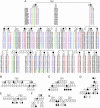A strabismus susceptibility locus on chromosome 7p
- PMID: 14519848
- PMCID: PMC218750
- DOI: 10.1073/pnas.2035118100
A strabismus susceptibility locus on chromosome 7p
Erratum in
- Proc Natl Acad Sci U S A. 2004 Mar 30;101(13):471-9
Abstract
Strabismus has been known to have a significant genetic component, but the mode of inheritance and the identity of the relevant genes have been enigmatic. This paper reports linkage analysis of nonsyndromic strabismus. The principal results of this study are: (i) the demonstrated feasibility of identifying and recruiting large families in which multiple members have (or had) strabismus; (ii) the linkage in one large family of a presumptive strabismus susceptibility locus to 7p22.1 with a multipoint logarithm of odds score of 4.51 under a model of recessive inheritance; and (iii) the failure to observe significant linkage to 7p in six other multiplex families, consistent with genetic heterogeneity among families. These findings suggest that it will be possible to localize and ultimately identify strabismus susceptibility genes by linkage analysis and mutation screening of candidate genes.
Figures


References
-
- von Noorden, G. (1996) Binocular Vision and Ocular Motility: Theory and Management of Strabismus (Mosby, St. Louis), 5th Ed.
-
- Francois, J. (1961) in Heredity in Ophthalmology (Mosby, St. Louis), pp. 255–269.
-
- Mash, A. & Spivey, B. (1973) Doc. Ophthalmol. 34, 285–291. - PubMed
-
- Paul, T. O. & Hardage, L. K. (1994) Ophthalmic Genet. 15, 1–18. - PubMed
-
- Holm, S. (1939) Acta Ophthalmol. 17, 367–387.
Publication types
MeSH terms
Substances
Grants and funding
LinkOut - more resources
Full Text Sources
Other Literature Sources

